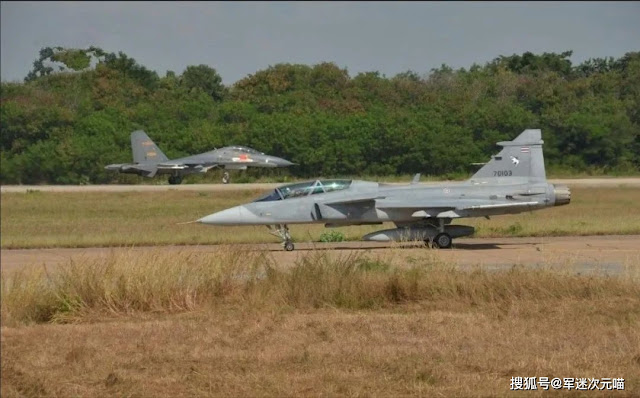J-10B / chinamil.com.cn / Photo by Luo Rong
2021-03-18 11:58
During the 2015 "Eagle Strike" joint air exercise, Su-27UBK and J-11A fighters conducted a series of discussions with the Royal Thai Air Force's 701 Squadron. Although they have achieved great victories in combat subjects, they have achieved great success in joint air defense and supervision. In the air combat link, the 701 Squadron relied on the avionics and data link advantages of the JAS-39 Gripen fighters to firmly suppress the Su-27 and J-11A fighters. Through this exercise, the Air Force also realized that it had not been modernized and upgraded. The early third-generation fighter jets of China are difficult to compete with the new-generation fighter jets of the West. However, through exercises in 2015, the Air Force also learned for the first time the performance and air combat tactics of Western fighters. In order to temper the troops, in the 2017 "Eagle Strike" joint exercises, the J-10A and J-10S fighters replaced the Su- 27 and J-11A, ready to fight against the Royal Thai Air Force’s JAS-39 Gripen fighters.
Since 2008, the Royal Thai Air Force has successively equipped 12 JAS-39C/D fighters. This fighter adopts a duck-type aerodynamic layout, has good short-range take-off and landing and maneuverability, and supersonic performance is also very good. According to the experience of fighting in 2015, the weaknesses of the JAS-39 fighter are mainly concentrated in vertical maneuvering and continuous hovering, and the energy decay speed is faster than that of the J-10, which also adopts the duck layout. The JAS-39C/D fighter uses the PS-05A flat-slot antenna radar developed by Ericsson, and is equipped with a MIL-STD-1553B data bus. Its performance is on par with the flat-slot antenna radar and GJB289A data bus of the J-10A equipment.
Compared with the Gripen fighter, the J-10A has better paper data. The engine thrust of the J-10A is greater (125 kN: 80 kN), and the take-off weight is greater (19 tons: 14 tons). The flight speed also has a slight advantage, and the pilots of the J-10A have gained experience feedback in 2015. This time it can be said that they are fully prepared. The J-10A has also repeatedly defeated the Su-27 and J-11A in exercises by relying on avionics advantages. Although 2017 was the first time that the J-10A played against a modern Western fighter, the confidence of the pilots was very sufficient.
However, according to the public information of the Royal Thai Air Force, during the 2017 joint exercise, the JAS-39 Gripen fighter performed well. It did not repeat the scene of the fiasco two years ago in the close combat subject, and although it did not in other subjects. It has achieved the same big victory as two years ago, but basically achieved a "five-five". The Royal Thai Air Force believes that compared with the Su-27 fighter, the performance of the J-10A is more balanced. In addition, Thai pilots have a better aerodynamic layout. The pros and cons are very well understood, so the fighting subject has the power to fight against the J-10A. The Thai media also interviewed the pilots of the J-10A. These ace pilots said they would reflect on them and try to win the next time.
In the joint exercise field in 2019, the more advanced J-10C began to play. In the face of the J-10C equipped with active phased array radar, the JAS-39 Gripen fighter was completely at a disadvantage, and it was no longer able to deal with the Soviet Union. Like the -27 fighter jets, requests are given in the over-the-horizon air combat link.






No comments:
Post a Comment